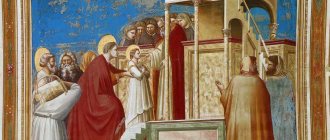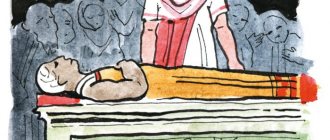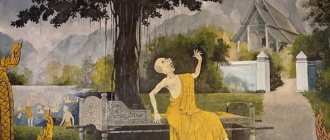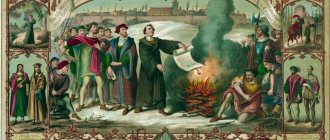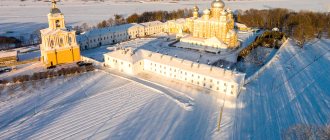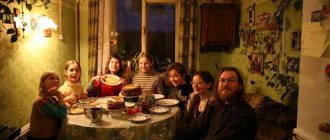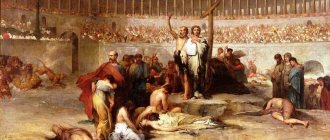In general, icon painting originated in Byzantium. Byzantine icon painters managed to create a visible image of the Almighty and show it to the world. It is not surprising that the entire Orthodox world accepted this way of incarnating God, and icon painting culture spread to all countries.
Of course, Byzantine icon painting did not develop overnight. It is customary to distinguish six periods in the development of icon painting:
The pre-iconoclastic period began in the 6th century AD and lasted about a hundred years; The iconoclastic period lasted from 730 to 843; The Macedonian period began in 843 and ended only in the 12th century; Komnenian period - occupied the 2nd half of the 11th century; 13th century ; The Palaiologan period - the shortest, took only the first decades of the 14th century.
Pre-Iconoclastic period
The icons of this period are characterized by the following features: the images were rough and schematic, since the icon painters did not draw small details; due to the schematic nature of the image, the icons were similar to each other. Icon painters of this time used a special painting technique (the so-called encaustic), which made it possible to preserve icons in their original form for a long time. Thanks to this, icons painted in the 6th and 7th centuries have survived to this day. The most famous icons of the pre-iconoclastic period are “Christ Pantocrator” and “Apostle Andrew”.
Painting icons in Russia
The first images in Russia appeared immediately after the baptism of Rus'. These were Byzantine icons that were painted to order. Masters were also invited for training. Thus, at first Russian icon painting was greatly influenced by Byzantine iconography.
In the 11th century, the first school arose in the Kiev Pechersk Lavra. The first famous icon painters appeared - Alypius and his “collaborator,” as recorded in one manuscript, Gregory. It is believed that from Kyiv Christianity spread to other Russian cities. Along with it comes icon painting.
After some time, very large schools emerged in Novgorod, Pskov, and Moscow. Each of them has formed its own characteristics in writing. At this time, signing images and assigning authorship to them came into use. We can say that from the sixteenth century the Russian style of writing completely separated from the Byzantine one and became independent.
If we talk about schools in particular, then the characteristic features of the Novgorod school were simplicity and conciseness, brightness of tones and large forms. The Pskov school has an imprecise drawing, which is more asymmetrical, but endowed with a certain expressiveness. Characterized by a slightly gloomy color with a predominance of dark green, dark cherry, red with an orange tint. The background of the icons is often yellow.
The Moscow school is considered the pinnacle of icon painting of that time. She was greatly influenced by the works of Theophanes the Greek, who brought certain traditions from Constantinople. Separately, there was the work of Andrei Rublev, who created magnificent examples of icons. In his work, he used a writing style that was characteristic of Byzantium in the 15th century. At the same time, he also applied Russian directions. The end result was some amazingly styled images.
It should be noted that although Russian iconography followed its own path, it retained all types of icon writing that were available in Byzantium. Of course, over time they have transformed somewhat, and even new ones have appeared. This was due to the emergence of new canonized saints, as well as special veneration for those who were of little importance in Byzantium.
In the 17th century, icon painting in Russia became more and more artistic than spiritual, and also acquired an unprecedented scope. Masters are increasingly valued and are also sent to other countries to paint temples. Russian icons are ordered and distributed to many Orthodox countries. In subsequent years, this art is only confirmed in mastery.
Icon painting in Russia during the Soviet Union experienced its decline, some ancient images were lost. However, now it is slowly being revived, new names of artists are appearing who are successful in this field.
Iconoclastic period
This period became the most difficult in the development of Byzantine icon painting, which had not yet been fully formed. In the thirties of the eighth century, an active and brutal struggle against religious opponents began in Byzantium. As a result of this struggle, many icon painters were declared heretics, and their works were destroyed. Instead of icons, artists were instructed to depict animals, plants, scenes from everyday life, etc. But this could not stop the development of icon painting. Many masters left for remote corners of the empire and continued their work. Italy became the center of icon painting, where many Byzantine icon painters moved.
Influence on Old Russian iconography
The icons of Byzantium, in all their aesthetic splendor, managed to make an invaluable contribution to the development of ancient Russian iconography. Since the main founders of cultural and religious education, first of all, it is the Roman icon painters who should be singled out. They managed to pass on their accumulated knowledge on creating church splendor not only to their future generation, but also to other states that existed at that time, one of which was Ancient Rus'.
( 1 ratings, average: 5.00 out of 5)
Macedonian period
In the forties of the ninth century, the iconoclastic period ended, and icon painting traditions were given the opportunity to continue and develop. At the same time, a new style in icon painting was emerging - the ascetic style. The basis of this style were icon samples painted by Greek masters. The features of this style are as follows: the icon painters tried to focus the viewer’s attention on the face of the saint, so small details and “extra” decorations were absent from the icons; the faces of the saints were completely devoid of emotions and feelings, they expressed practically nothing; The main object of the entire image was the huge eyes with a frozen gaze. A typical example of an icon from the Macedonian period are two icons of Our Lady Hodegetria, which have survived to this day.
The meaning of icons of the Mother of God in the lives of believers
The Mother of God has always occupied a special place in Christianity. From the very first days, she was an intercessor and defender of both the common people and cities and countries. Obviously, this is why there are so many icons of the Mother of God. According to legend, its first images were painted by Luke, the evangelist. Icons of the Mother of God have special miraculous power. Also, some lists, written from different images, became healing and protective over time.
If we talk about which icon of the Mother of God helps in what way, then you should know that in different troubles you should ask for help from different images. For example, the image of the Mother of God, called “Seeking the Lost,” will help with headaches, eye diseases, and will also help with alcoholism. The icon “It is worthy to eat” will help with various diseases of the soul and body, and it is also good to pray to it after completing any task.
Palaiologan period
In the middle of the 13th century, Constantinople was returned by the Greeks, which could not but leave its mark on icon painting traditions. During this period, the influence of ancient culture and art is felt. The icons of this period are quite different from the earlier icons. The faces of the saints are depicted very well; one gets the feeling that the icon painter was painting a portrait of the saint. The real masterpieces of the Palaiologan period are: the icon “St. Theodore Stratelates”, the icon “Twelve Apostles”, the icon “Christ Pantocrator”.
Share link
“Mourning”
The “Sorrowful” icon is an image of the Mother of God with downcast eyes that are covered by eyelids. The whole image shows the mother's grief over her lost son. The Mother of God is depicted alone, and there are also images with a baby.
There are many spelling options. For example, in Jerusalem, in the Chapel of the Bounds of Christ, there is an ancient icon depicting the Weeping Mother of God. In Russia, the miraculous image “Joy of All Who Sorrow” is popular, which is famous for its healings.
The “Sorrowful” icon is a helper and savior during the loss of loved ones; prayer to this image will help strengthen one’s faith in eternal life.
Byzantine icon painting tradition
The period from the mid-9th to the 14th centuries was the time of the greatest flowering of Byzantine mosaics and frescoes. One of the earliest monuments of this period is the mosaic of the Hagia Sophia in Thessaloniki. The composition “Ascension” (880–885) is located in the dome of the temple. In the center is Christ in a medallion, with a disproportionately large head, sitting on a rainbow. The medallion is supported by two flying Angels in white robes with multi-colored wings. Directly below Christ, in the drum of the dome, the Mother of God is depicted in full height with raised arms (“Oranta”), on both sides of Her are two Angels pointing with their hands to the ascending Christ. In the same row are the twelve apostles, separated from one another by tall trees with bare trunks and green crowns. In the conch of the apse the Mother of God and Child are depicted sitting on a throne (the turn of the 11th and 12th centuries). In the vault of the altar vima there is an image of a cross left over from the times of iconoclasm.
An outstanding monument of Christian fine art from the Macedonian Renaissance are the mosaics of the monastery of Hosios Loukas (St. Luke), dating from the 1st half of the 11th century and perfectly preserved. The dome of the temple depicts Pentecost: in, on top of which is a dove with its head in a golden halo, symbolizing the Holy Spirit. From the medallion, rays of light descend on the twelve apostles sitting in the dome, and above the head of each apostle there is a tongue of flame. The apostles are depicted sitting on thrones and talking with each other; Each apostle holds the Gospel in his hand. In the sails of the dome are representatives of different nations in fancy clothes standing and listening to the apostles. The conch of the altar apse is occupied by an image of the Virgin and Child sitting on a throne. The Christological cycle consists of four compositions in the main part of the temple (“Annunciation”, “Nativity”, “Candlemas” and “Baptism”) in the sails above the tympanum of the dome, scenes of the Passion in the narthex (“Washing of the feet”, “Crucifixion”, “Descent into Hell” ") and "Pentecost" in the small dome above the altar. The rest of the temple space is decorated with many images of saints (about 150) with wide-open, disproportionately large eyes and dark pupils: among the saints, the venerables occupy a significant place, which is due to the monastic nature of the building. In the deaconne mosaics on Old Testament scenes have been preserved: Daniel in the lion's den, three youths in the furnace of Babylon.
In addition to the mosaics, a number of frescoes dating from the mid-10th to the first quarter of the 11th century have been preserved in Hosios Loukas. One of them depicts Joshua in military clothing: he has a helmet on his head, chain mail is put on his body, a spear in his left hand, and a sword in his belt. The composition “The Meeting of Christ with John the Baptist” is placed in two arches: in the left arch there is a depiction of the Forerunner facing Christ in a cloak lined with wool, with a cross in his right hand and his left hand extended to Jesus; in the right arch - Christ with a scroll in his left hand and his right hand raised in a gesture of blessing; The Forerunner is depicted standing on the ground, Jesus walking towards him. In the composition “The Entry of the Lord into Jerusalem” Christ, with a scroll in his hand, sits on a donkey; a child climbing a tree looks at Christ; the people with palm branches greet the coming Messiah. In the Entombment scene, Christ is depicted wrapped in burial shrouds; only His face with closed eyes remains open; the grieving Mother of God bent over the body of Christ; Joseph and Nicodemus support the body with their hands. The same composition depicts another scene from the gospel story: two myrrh-bearing women at an empty tomb, on the lid of which an Angel sits.
The surviving mosaics of the Church of Hagia Sophia in Constantinople give only a partial idea of the ensemble of its interior decoration. Great importance in mosaics was given to the images of Christ and the Virgin Mary, as well as images of emperors and empresses. In the conch of the altar apse, a mosaic image of the Mother of God on a throne with the Child sitting on Her lap, made in 867, has been preserved. The pose of the Mother of God is static, the figure is majestic, the body, dressed in a dark blue maforium, is disproportionately large compared to the head; The faces of the Mother and Baby are designed in ancient traditions. A mosaic image of Christ on a throne with an open Gospel dates back to the beginning of the 10th century; on two sides of Christ there are medallions depicting the Mother of God and the Archangel; at the foot of the throne is Emperor Leo VI the Wise (886–912), bowed in reverent prayer. At the turn of the 10th and 11th centuries, a mosaic image of the Mother of God enthroned with the Child was created; On Her right hand stands Emperor Justinian with a model of the Church of Hagia Sophia in his hands, on Her left hand stands Constantine the Great with a symbolic model of the city. The image of Christ on the throne with the upcoming Emperor Constantine Monomakh and Empress Zoe dates back to 1044. Around 1118, a mosaic was created in which Emperor John Komnenos and Empress Irene are depicted next to the Virgin Mary holding the Child in her arms.
The most impressive in terms of the power of expression of all the surviving mosaic compositions of the Sophia of Constantinople is the Deisis, dating back to 1261. In the center of the composition is Christ in a blue himation with his right hand raised in a blessing gesture and the Gospel in his left. The face of Christ is marked with the stamp of soft concentration, the nose is elongated, the lips are full. The eyes, as on the Sinai icon of Pantocrator, are asymmetrical; the gaze is unfocused, which creates a feeling of the presence and at the same time of some detachment of Christ from the person praying. The Mother of God and John the Baptist are turned half-turned to the Savior: their faces are marked with the stamp of sorrow and concentration.
The mosaics of the Hagia Sophia in Kyiv are one of the most remarkable monuments of Byzantine fine art of the 1st half of the 11th century. In general, the program of the interior decoration of the temple is focused on Byzantine models. From the original mosaic ensemble, which occupied an area of 640 square meters. m, only about 260 sq. m, but the surviving mosaics give an idea of the grandeur of the plan and the perfection of its implementation. In the dome of the temple there is a medallion with the image of Christ Pantocrator, under it there are four figures of Archangels (only one of them has been partially preserved). In the drum of the dome, between the windows, there were images of the apostles (only part of the figure of the Apostle Paul survived); in the sails are four evangelists (only Mark survived). On the arches supporting the dome, there were four medallions, of which two have survived - the Mother of God and Christ the Priest: the latter is a “Semitic-Palestinian” type of image of Christ with short curly hair and a closely trimmed beard. On the transverse arches there are medallions with images of the forty martyrs of Sebaste (15 medallions out of forty have survived). In the conch of the apse the Mother of God “Oranta” is depicted in full height: Her figure (5.45 m high) dominates the entire mosaic ensemble of the temple. Above the “Oranta” is the Deisis in three medallions; under the “Oranta” in the middle register is “Communion of the Apostles” (Christ is depicted twice), and in the lower register is the rite of saints, in the center of which deacons with monstrances are depicted in a three-quarter turn, which gives the entire rite a distinctly liturgical character. The composition “Annunciation” is placed on the pillars in front of the altar concha. On the walls of the cathedral there are numerous images of saints. The figures of Christ, the Virgin Mary and saints in the compositions of the Kyiv Sophia are distinguished by their static and monumental nature; frontal poses predominate. The facial features of most of the characters are emphasized geometric, the eyes are enlarged, the lips are full, the nose is wide.
An outstanding monument of Byzantine monumental painting are the frescoes of the Church of Hagia Sophia in Ohrid (Macedonia), dating back to 1037–1056. The frescoes are distinguished by their craftsmanship, expressiveness of faces, and compositional diversity. In the conch of the altar apse the Virgin Mary is depicted in a static pose, seated on a throne; in Her hands in an oval medallion is the Child Christ. In the lower register - the communion of the apostles: in the center of the composition is Christ, standing under the ciborium and facing the viewer; His right hand is raised in a gesture of blessing, in his left hand He holds bread; on either side of the Savior are two Angels; on the right and left, the apostles approach the Savior, lined up in a row. On the vault of the altar apse there is a grandiose composition “The Ascension”, in the center of which in a medallion there is a depiction of Christ sitting on a rainbow; The medallion is supported by four Angels. On two sides of the medallion there are rows of apostles and angels (one angel in each row); the apostles are presented in dynamic poses with their faces turned to the ascending Christ; among the apostles is the Mother of God. Under each row there is another one, in which Angels are depicted. The walls of the altar apse are decorated with images of saints, scenes from the Old Testament related to the Eucharist (in particular, the hospitality of Abraham), and scenes from the New Testament.
The grandiose ensemble of mosaics of the Monastery of the Dormition of the Virgin Mary in Daphni (Greece) dates back to the end of the 11th century, the time of the so-called Comnenian Renaissance. The ensemble is dominated by the image of Christ Pantocrator: high eyebrows, a gaze directed to the side, folds on the face, forehead and neck, a powerful torso - all this gives the image a severity unusual by Byzantine standards. Sixteen prophets are depicted in the dome drum. In the altar apse there is the Mother of God with the prophets worshiping Her. Much attention is paid to multi-figure compositions dedicated to the main church holidays. The figures of the characters are dynamic and graceful; the characters are presented in a wide variety of poses - frontal, profile, half-turned; The faces are marked with the stamp of calm and concentration. Angels are the protagonists of many compositions, which creates a feeling of the constant presence of Heavenly Forces in a person’s life. The Theotokos cycle includes numerous compositions from the life of the Mother of God, including Her birth, Introduction, and Dormition. In general, the mosaic ensemble is characterized by a desire for the most complete reflection of the main events of the liturgical year: the theme of the mosaics is focused not so much on the sequence of Gospel events, but on the church calendar.
The painting of the Assumption Church in the village dates back to the 90s of the 11th century. Ateni (Ateni Zion). Georgian monumental painting was genetically connected with Byzantium, but had pronounced national features, which were fully reflected in the painting of Aten Zion. In the conch of the altar apse the Mother of God Nikopea is depicted with the Infant Christ, on either side of Her are the Archangels Michael and Gabriel. Below is the composition “Eucharist” with the apostles facing Christ. In the lowest register there are saints, in the openings between the windows there are stylites. Other images of the altar apse include Archdeacon Stephen and the Venerable Roman the Sweet Singer, as well as the patrons of the temple, including King David IV the Builder. In the northern apse there is a cycle of 12 holidays, in the southern - 14 scenes from the life of the Blessed Virgin Mary, in the western - the Last Judgment. The trompos (instead of the evangelists) depict personified biblical rivers Nile, Pishon, Tigris and Euphrates in the form of young men on the waves. The general style of the paintings indicates that they belonged to Georgian masters. Dark colors predominate, the silhouettes of the figures are clearly defined, the images are distinguished by their monumentality, staticity and heaviness of forms.
During the 12th – first half of the 13th centuries, a number of mosaic ensembles of the Byzantine style were created in churches in Italy, in particular in the Sicilian cities of Cefalu, Monreale and Palermo, in Venice and Rome. The mosaics of the altar apse of the Cathedral of Cefalu, dating from the 1st half of the 12th century, represent one of the most perfect works of Byzantine art. According to the researcher, “these mosaics amaze at first glance with the noble beauty of their purely Byzantine forms. The figures are distinguished by the severity of their proportions, the design by their remarkable strength, the interpretation of the clothing by an almost ancient grace.” The image of Pantocrator in the conch is particularly refined, his hair and beard are carefully modeled, and his facial expression is emphatically ascetic. Below Pantocrator there is an “Oranta” of much smaller size, with two Angels on each side of Her. The lower registers of the altar apse are occupied by images of the apostles. Christ and the Mother of God are presented in strictly frontal poses, while the figures of the apostles are given in various turns. The graphic nature of the design, the precision and clarity of the lines are combined in Cefalu's mosaics with the expressiveness of the images, each of which has its own characteristic features.
In the mosaics of Italy, Byzantine influence coexists with the influence of Latin theology and local traditions. One of the 12th century mosaics in Torcello (Venice) shows the composition “The Second Coming”, which includes four registers. In the center of the upper register, in an oval medallion, a seated Christ is depicted with his arms stretched down, palms facing the audience (He shows the wounds from the nails on his hands). A fiery stream flows from the medallion, dividing the composition into the kingdom of the saved (to the left of the viewer, that is, to the right hand of Christ) and the kingdom of the condemned (to the left). On the sides of Christ stand the Mother of God and John the Baptist, followed by a host of Angels. In the same register, the apostles are depicted in white robes, with Gospels or scrolls in their hands; Peter, according to tradition, holds the keys. In the center of the second register is the “Prepared Throne” with an eight-pointed cross standing behind it; near the cross there are two Angels, at the foot of the Throne - Adam and Eve kneeling. On the left side of the second register are depicted Angels opening the doors of heaven to the righteous; on the right are Angels plunging the heads of sinners into eternal fire; Inside the flame, Satan is depicted as a green creature with white claws, white hair and a beard, sitting on a two-headed dragon. The left side of the third register is occupied by images of the saved: saints, martyrs, saints and holy women turned to Christ in prayer. On the right side are sinners condemned to torment, presented naked. The left side of the lower register is occupied by the image of a Cherub guarding the entrance to paradise, a prudent thief with a cross at the door of paradise, Abraham and Sarah with numerous offspring. On the right side are the various compartments of hell. The entire composition as a whole reflects not so much the Byzantine vision of posthumous reward for sinners, but rather the idea of the Second Coming, the Last Judgment and eternal torment, which is characteristic of the Latin Middle Ages.
The mosaics of St. Mark's Cathedral in Venice, modeled after the Church of the Holy Apostles in Constantinople, were created over three centuries - from the 12th to the 14th centuries. Masters - both Greek and local origin - followed the program of pictorial decoration of the temple that had developed in Byzantium, but introduced elements characteristic of Western art. A significant part of the mosaics was damaged and was redone in a later era. The mosaics of San Marco represent an ensemble rich in content, including multi-figure compositions executed with virtuoso skill. Often several scenes are combined into one composition. The scenes of the Passion Cycle, created at different times, are united by expressiveness and dynamism. In the scene of the betrayal of Judas (1180–1190), the facial features of the negative characters (Judas, soldiers, high priests) are almost grotesque, many characters are depicted in profile. In the scene of the Battle of Gethsemane (13th century), the sleeping apostles are depicted in a realistic manner; each sleeps in a position that is characteristic only of him: one with his head resting on his hand, another with his head on his knees, a third lying on his back, a fourth with his head bowed on the knees of the fifth, etc.
On the ceiling of the western porch of the temple there is a composition “The Creation of the World” (1st half of the 13th century), illustrating the first two chapters of the book of Genesis. (There is also a similar composition in the cathedral in Montreal in Sicily.) In the center of the composition is a medallion with an ornament inside. The medallion is surrounded by three registers of images: the main character of most of them is the Creator, represented as a Youth in a cross-shaped halo; in this image the “antique” image of Christ as the Good Shepherd was revived. The days of creation are symbolized by angelic creatures in white robes, the firmament is symbolized by a circle in which the sun and moon with human faces, as well as six-pointed stars, are inscribed. The story of Adam begins in the second register and continues in the third: Adam’s face in its main features resembles the face of the Creator, which indicates the creation of Adam in the image and likeness of God. (In the Montreal Cathedral mosaics, where the Creator is represented with a beard and long hair, Adam also has a beard and long hair.) Eve's facial features, in turn, are similar to those of Adam. The composition amazes not only with the perfection of its artistic design, but also with the richness of its theological content.
In the period from the 12th to the 14th centuries, many temples in Asia Minor, Greece, Cyprus, Macedonia, Serbia and other countries were decorated with frescoes.
The richest collection of frescoes has been preserved in several churches in the Greek city of Kastoria (province of Western Macedonia). The churches of St. Nicholas of the Execution, the Unmercenary Saints Cosmas and Damian and Panagia Mauriotissa are distinguished by the special richness of their interior decoration. The Church of St. Nicholas was painted in 1160–1180; Gospel stories predominate, as well as scenes from the life of the saint; One of the frescoes depicts the builder of the temple, Nikifor Kaznitsis, and his wife Anna, holding a model of the temple. The Church of the Holy Unmercenaries was painted in a similar style around 1180. The composition “Lamentation of Christ” (a widespread subject in the painting of Byzantine churches) is distinguished by its deep expressiveness. Inner restraint is present in the faces of the great martyrs, whose images decorate the walls of the temple. The painting of both temples is dominated by the desire for realism and expression; the faces are carefully depicted, the poses are flexible and expressive; the drawing is accurate and graphic. The style of paintings in the temple of Panagia Mavriotissa, dating back to the beginning of the 13th century, is somewhat different: the correct proportions are not always observed in the figures, the figures are somewhat angular, the faces are more schematic and conventional.
Impressive fresco ensembles have been preserved in Serbian churches: the Virgin Mary in Studenica (1208–1209), the Holy Apostles in Pec (1230–1240), the Savior in Mileshevo (1st half of the 13th century), the Holy Trinity in Sopocani (the earliest frescoes date back to by 1265, later ones - by the 13th century and the 40s of the 14th century), Our Lady in Gračanica (c. 1320), the Savior in Decani (c. 1348) and others. These frescoes combine Byzantine style with local influences. The plots are dominated by traditional themes: scenes from the Old and New Testaments, images of ancient saints. However, there are also images of people who played an important role in the history of Serbia and its Church: St. Sava, King Vladislav and his brother Radoslav (in Studenica), King Uros and his mother Anna (in Sopocany). Some images from Serbian churches have become world famous, for example, the Angel on the stone of the empty tomb from the painting of the Milesevo Church.
Of no less interest are the surviving frescoes of Macedonian churches of the same period: St. Panteleimon in Nerezi (1164), St. George in Kurbinovo (1191), Theotokos Perivelepta in Ohrid (1295), St. George in Staro Nagorichina (1317–1318), St. Demetrius in the Markov Monastery (c. 1370) and others. In the dome of the Panteleimon Church in Nerezi, Christ Pantocrator is depicted, in the apse conch there is a half-figure of “Oranta” with the Child in a round medallion. The lower register of the apse is occupied by the composition “Eucharist”, the center of which is an oblong altar with bread and wine standing on it; behind the altar are two Angels with ripids at the ciborium; on the sides of the altar is Christ, depicted twice, distributing Communion to the disciples. On the walls of the altar there are depictions of saints standing half-turned towards the viewer, with scrolls in their hands. In front of the altar barrier is the image of St. Panteleimon, the heavenly patron of the temple, in a carved marble icon case. The walls of the temple are decorated with multi-figure compositions depicting various scenes from the Holy Scriptures. Unsurpassed masterpieces are the compositions of the Passion Cycle - “The Descent from the Cross” and “The Lamentation of Jesus”: in terms of the power of expression, they have no equal in Byzantine painting. In both scenes, the Mother of God with a mournful face (sorrow conveyed in the lines of her eyebrows, raised high towards the center and lowered at the edges, in the curve of her lips, in her eyes filled with tears) clung to the face of the dead Christ. In the scene of “Lamentation,” the Mother of God holds the body of Christ with two hands, one clasping the neck, the other the waist, so that the Savior reclines in Her bosom (this unusual arrangement of figures emphasizes the motherhood of the Mother of God, Her blood connection with the Savior born of Her). John and Joseph with Nicodemus bowed before the body of the Deceased in reverent prayerful poses; Half-figures of Angels hover above the entire composition.
The small-sized church in Kurbinovo amazes with the abundance of multi-figure compositions executed with virtuoso skill (art historians distinguish the style of three masters). The main part of the frescoes dates back to the 12th century, some were added in the 16th century. In the conch of the apse the Virgin Mary is depicted sitting on a throne with the Infant Christ playing in Her arms; on the sides of the Mother of God are the Archangels Michael and Gabriel. The lower register of the apse is occupied by images of saints. Above the apse is the composition “Ascension” with Christ in a medallion, Angels, the Virgin Mary and the apostles. On the sides of the apse there is the Annunciation: on the left side there is an Angel in a dynamic and graceful pose, with detailed folds of clothing; on the right is a half-sitting Virgin Mary in an equally unexpected pose: Her head is turned towards the Archangel, and her bent knees are in the other direction. The walls of the temple are decorated with numerous images of saints, as well as the holy great martyrs - Thekla, Paraskeva, Theodora, Barbara, Anastasia and Catherine. Multi-figure compositions are dedicated to the main church holidays. In terms of originality of composition and mastery of execution, the composition “The Descent of Christ into Hell” stands out: Christ is presented in the center in a pose of rapid movement; with his right hand He holds Adam's hand; in His left hand He has a cross with a crown of thorns; the head is strongly tilted towards Adam; the himation flutters in the wind. The figure of Christ is inscribed in a circle divided by eight rays of light into eight segments; the direction of the main lines forming the figure coincides with the direction of the rays, which gives the entire composition almost geometric regularity and strict proportionality.
The frescoes of the Church of the Blessed Virgin Mary and the refectory of the Monastery of the Holy Apostle John the Theologian on the island date back to the end of the 12th - beginning of the 13th century. Patmos (Greece). Painted with remarkable skill, the frescoes represent an outstanding monument to monumental painting. One of the frescoes depicts “The Hospitality of Abraham” - a plot known from the paintings of the Roman catacombs and mosaics of Ravenna. However, in this case, above the three Angels sitting in static poses, there is the inscription “Holy Trinity”. The right and left Angels are written half-turned, the middle one faces the viewer; the right hand of each Angel is raised in a blessing gesture; in the left hands of the two lateral Angels there are rods, in the left hand of the middle Angel there is a scroll. The figure of the middle Angel takes center stage; he is dressed in a blue himation and a dark red tunic (the characteristic colors of Christ’s clothing), while the other two Angels are dressed in light himation and tunics. On the table are three breads, three knives and a dish with the head and bones of a calf. In the left corner of the composition, Abraham is represented with a dish in his hands; Sarah is missing.
The Temple of Athonite Protat (northern Greece) was painted around 1290 by the legendary artist Manuel Panselin (information about him was preserved in the work of the 18th century Athonite artist Dionysius of Fourna). The iconographic program of the temple is divided into several thematic cycles, each of which is placed in a separate register. The festive cycle includes events from the life of Christ based on the Gospel. The Theotokos cycle is based both on the Gospel narrative and on information from Church Tradition; The culmination of the Virgin cycle is the fresco “Assumption”, which occupies the entire western wall of the central nave: this is the most multi-figured composition in the entire ensemble. The passion cycle consists of eight compositions illustrating the last days, hours and minutes of Christ's earthly life. The Easter cycle includes four compositions dedicated to the appearance of Christ to the disciples after the resurrection. Seven compositions make up a cycle associated with the holiday of Pentecost and corresponding to the celebrations reflected in the liturgical book of the Colored Triodion (Pentikostarion). The walls of the temple are decorated with many images of saints: ancestors and prophets, evangelists and other apostles, saints and deacons, monks, warriors, martyrs, unmercenaries and healers. Panselin paid special attention to the images of saints who came from Thessaloniki, his hometown.
Panselin's art is distinguished by its special spiritual depth, plastic clarity, beauty of images and brightness of colors. The artist gravitates toward symmetrical compositions, portrait realism, and sculptural depictions of the human body. The influence of hesychasm is felt in the artist’s art; the faces - be it of Christ on the throne, the Mother of God on the throne, the great martyrs Theodore Stratelates or Theodore Tyrone - breathe inner silence and spirituality. The faces of Christ in single and multi-figure compositions are extremely diverse. One of the frescoes, known as “Christ Sleeping,” depicts the Baby lying on a pillow: the Baby’s eyes are open, but His facial expression is sleepy, He props up his head with his hand. In another fresco, Christ is represented as a young man with short curly hair and a short beard (Semitic-Palestinian type); the inscription reads: “Jesus Christ in another form.” In the composition “Descent into Hell” Christ is depicted bending towards Adam, whom he leads out of hell; the Savior’s facial features are marked with the stamp of compassion and calm; the faces and figures of Adam and Eve, on the contrary, are full of drama.
One of the peaks of fine art of the Palaeologian Renaissance is the ensemble of mosaics of the Constantinople monastery of Chora (Kahrie Jami). The temple, built in the 12th century, is a domed building, to which three more buildings are attached, each with its own dome: narthex, exonarthex and pareclesium. The temple was decorated with mosaics at the beginning of the 14th century. In one of the domes of the temple, Christ is depicted in a medallion; 24 forefathers were arranged in rows around the medallion. In the dome of the narthex there is the Mother of God, around whom there are 16 forefathers. Thus, all of Christ’s ancestors mentioned in His genealogy (Matthew 1:1–16) are represented in the mosaic ensemble of two domes. The walls, vaults and sails of the narthex are decorated with numerous scenes of healings and miracles from the Gospel, episodes from the life of the Blessed Virgin Mary, and images of saints. Images of Christ and the Virgin Mary dominate the ensemble of figures. On one of the mosaics of the narthex, Christ is depicted sitting on a throne; at the foot of the throne, kneeling at the foot of the throne is the temple ktitor Theodore Metochites, the great logothete (first minister) of Emperor Andronikos II Palaiologos, in a high headdress, holding out a model of the temple to the Savior. In another mosaic, Christ is shown standing; on His right hand is the praying Mother of God, half-turned to Him; at the bottom of the composition are small figures of the sebastocrator Isaac Komnenos and the nun Melania (presumably the half-sister of Emperor Andronikos II Palaiologos). In the lunette of the exonarthex there is an impressive image of Christ “Land of the Living”.
The mosaic ensemble of the monastery is complemented by an ensemble of frescoes located in the parekklesia of the monastery and created in 1315–1320. The semantic center of the ensemble, which includes several multi-figure scenes and numerous single images of saints, is the composition “Resurrection”. The traditional theme of the “Descent into Hell” (more precisely, the exodus from hell) is interpreted here with special drama. In the middle of the composition is a frontal image of Christ in white clothes; Christ stands with his legs spread wide apart and holds Adam’s hand with his right hand and Eve’s hand with his left. Adam and Eve are presented in dynamic poses: Adam almost running towards Christ, Eve rising with effort from the depths of hell. On the right hand of Christ (to the left of the viewer) John the Baptist and the Old Testament righteous with halos are depicted. On the left hand (to the right of the viewer) are the Old Testament sinners, led by Cain, the son of Eve, standing in indecision.
Origin of the Smolensk Icon of the Mother of God
This image, in its iconographic type, belongs to Hodegetria, and it is the most famous icon. It is not known for certain whether this is an original or just a list. The Smolensk icon came to Russia in 1046. It was like Constantine IX Monomakh’s blessing for his daughter Anna to marry Prince Vsevolod Yaroslavich of Chernigov. Vsevolod’s son, Vladimir Monomakh, moved this icon to Smolensk, where it was kept in the Church of the Dormition of the Mother of God, which he also built. This is how this image got its name.
Subsequently, the icon performed many different miracles. For example, 1239 could have been fatal for Smolensk. Batu’s huge horde at that time was marching across Russian land, approaching the city. Through the prayers of the inhabitants, as well as the feat of the warrior Mercury, before whom the Mother of God appeared in a vision, Smolensk was saved.
The icon traveled often. In 1398 it was brought to Moscow and placed in the Annunciation Cathedral, where it remained until 1456. This year a list was written from it and left in Moscow, and the original was sent back to Smolensk. Subsequently, the image became a symbol of the unity of the Russian land.
By the way, the original icon of the Mother of God (Byzantine) was lost after 1940. In the 1920s, by decree, she was confiscated to the museum, after which her fate is unknown. Now in the Assumption Cathedral there is another icon, which is a scroll. It was written in 1602.
Image of Saints Peter and Fevronia
The life story of Peter and Fevronia of Murom shows how pious and devoted to the Lord one can be, even while in family ties. Their family life began with Fevronia healing her future husband from scabs and ulcers on his body. For this, she asked him to marry her after he was cured. Of course, the prince did not want to marry the poison dart frog’s daughter, but Fevronia foresaw this. The prince’s illness resumed, and even then he married her. They began to rule together and became known for their piety.
Of course, the reign was not cloudless. They were expelled from the city, then asked to return. After this, they ruled until old age, and then took monasticism. The couple asked to be buried in one coffin with a thin partition, but their order was not carried out. Therefore, they were carried twice to different temples, but they still miraculously ended up together.
The icon of Fevronia and Peter is the patroness of a true Christian marriage. The life image of the saints, which dates back to 1618, is now in Muromsk, in the Historical and Art Museum. Also, icons of saints can be found in other churches. For example, in Moscow, the Church of the Ascension of the Lord has an image with a particle of relics.
Icon of Seraphim of Sarov
Seraphim of Sarov is a Russian wonderworker who founded the Diveyevo women's monastery and subsequently became its patron. He was marked with God's sign from an early age; after falling from the bell tower, he was delivered from illness after praying before the icon of the Mother of God. At the same time, the saint had a vision of her. Seraphim always strived for monasticism, so in 1778 he was accepted as a novice at the Sarov monastery, and in 1786 he became a monk there.
Very often the Monk Seraphim saw angels, once he even had a vision of the Lord Jesus Christ. Subsequently, the saint strove for solitude and had experience of living in the desert. He also performed the feat of pillar-bearing for a thousand days. Most of the exploits of this time remained unknown. After some time, Seraphim of Sarov returned to the Sarov monastery, as he could not walk due to leg disease. There, in his old cell, he continued his prayer before the icon of the Mother of God “Tenderness”.
According to the stories, after some time the Mother of God ordered him to stop being a recluse and begin to heal human souls. He received the gift of clairvoyance, as well as miracles. Obviously, this is why today the icon of Seraphim of Sarov is of great importance for the believer. The monk knew about his death and prepared for it in advance. I even told my spiritual children about her. He was found praying before the icon of the Mother of God, which had been with him all his life. After Seraphim's death, many miracles were performed at his grave; in 1903 he was canonized.
The icon of Seraphim of Sarov has meaning for those who are depressed. Prayer will also help in grief. In any of the physical and spiritual illnesses, the icon of the saint will help. There is also a prayer rule of Seraphim of Sarov.
